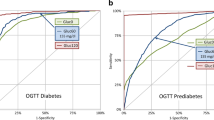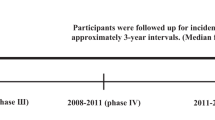Abstract
Objective:
Although there is evidence of increasing prevalence of impaired glucose metabolism in obese children from smaller single cohorts, data are lacking on the progression of glucose metabolism in this patient group.
We aimed to assess the prevalence and the longitudinal course of impaired glucose metabolism assessed by oral glucose tolerance test (oGTT) in a large multi-center pediatric obesity registry.
Subjects:
We performed an observational multicenter (n=84) cross-sectional (n=11 156) and longitudinal analysis (n=1008) on the course of glucose metabolism evaluated by oGTT in obese children documented in the Adiposity Patients Verlaufsbeobachtung (APV) registry. Patients were stratified with impaired fasting glucose (IFG), impaired glucose tolerance (IGT) and Type 2 diabetes (T2D), according to American Diabetes Association criteria.
Results:
A total of 12.6% of the children presented with abnormal glucose metabolism (5.99% IFG, 5.51% IGT, 1.07% T2D). Body mass index (BMI) correlated modestly with 2-h blood glucose (r=0.04, P<0.001).
In the 1008 patients with follow-up oGTT, metabolic parameters improved and the percentage of abnormal glucose metabolism decreased from 18.7 to 14.2%. Of the children with initial IGT, 70.6% converted to normal glucose tolerance. The improvement in oGTT results was associated with, but not dependent on, a reduction of BMI s.d. score.
Conclusion:
In summary, we provide evidence for significant improvement of oGTT parameters in obese children treated in specialized treatment centers, even though reduction in BMI was modest.
This is a preview of subscription content, access via your institution
Access options
Subscribe to this journal
Receive 12 print issues and online access
$259.00 per year
only $21.58 per issue
Buy this article
- Purchase on Springer Link
- Instant access to full article PDF
Prices may be subject to local taxes which are calculated during checkout


Similar content being viewed by others
References
Körner A, Kratzsch J, Gausche R, Schaab M, Erbs S, Kiess W . New predictors of the metabolic syndrome in children--role of adipocytokines. Pediatr Res 2007; 61: 640–645.
Franks PW, Hanson RL, Knowler WC, Moffett C, Enos G, Infante AM et al. Childhood predictors of young-onset type 2 diabetes. Diabetes 2007; 56: 2964–2972.
Franks PW, Hanson RL, Knowler WC, Sievers ML, Bennett PH, Looker HC . Childhood obesity, other cardiovascular risk factors, and premature death. N Engl J Med 2010; 362: 485–493.
Must A, Strauss RS . Risks and consequences of childhood and adolescent obesity. Int J Obes Relat Metab Disord 1999; 23 (Suppl 2): S2–S11.
Reinehr T, Wabitsch M, Andler W, Beyer P, Böttner A, Chen-Stute A et al. Medical care of obese children and adolescents. APV: a standardised multicentre documentation derived to study initial presentation and cardiovascular risk factors in patients transferred to specialised treatment institutions. Eur J Pediatr 2004; 163: 308–312.
Reinehr T, Holl RW, Wabitsch M . The German Working Group of Obesity in Childhood and Adolescence (AGA): improving the quality of care for overweight and obese children in Germany. Obes Facts 2008; 1: 26–32.
Kromeyer-Hauschild K, Wabitsch M, Geller F, Ziegler A, Geiß HC, Hesse V et al. Perzentilen für den Body Mass Index für das Kindes- und Jugendalter unter Heranziehung verschiedener deutscher Stichproben. (Centiles for body mass index for children and adolescents derived from distinct independent German cohorts). Monatsschr Kinderheilkd 2001; 149: 807–818.
World Health Organization. Definition and Diagnosis of Diabetes Mellitus and Intermediate Hyperglycemia WHO/IDF Consultation: Geneva, 2006.
Littell RC, Henry PR, Ammerman CB . Statistical analysis of repeated measures data using SAS procedures. J Anim Sci 1998; 76: 1216–1231.
Moss A, Kunze D, Wabitsch M . [Evidence-based therapy guideline of the german working group on obesity in childhood and adolescence]. Bundesgesundheitsblatt Gesundheitsforschung Gesundheitsschutz 2011; 54: 584–590.
Sinha R, Fisch G, Teague B, Tamborlane WV, Banyas B, Allen K et al. Prevalence of impaired glucose tolerance among children and adolescents with marked obesity. N Engl J Med 2002; 346: 802–810.
Fagot-Campagna A, Saaddine JB, Flegal KM, Beckles GL . Diabetes, impaired fasting glucose, and elevated HbA1c in U.S. adolescents: the Third National Health and Nutrition Examination Survey. Diabetes Care 2001; 24: 834–837.
Invitti C, Guzzaloni G, Gilardini L, Morabito F, Viberti G . Prevalence and concomitants of glucose intolerance in European obese children and adolescents. Diabetes Care 2003; 26: 118–124.
Must A, Jacques PF, Dallal GE, Bajema CJ, Dietz WH . Long-term morbidity and mortality of overweight adolescents. A follow-up of the Harvard Growth Study of 1922 to 1935. N Engl J Med 1992; 327: 1350–1355.
Mossberg HO . 40-Year follow-up of overweight children. Lancet 1989; 2: 491–493.
Kleber M, Lass N, Papcke S, Wabitsch M, Reinehr T . One-year follow-up of untreated obese white children and adolescents with impaired glucose tolerance: high conversion rate to normal glucose tolerance. Diabet Med 2010; 27: 516–521.
Weiss R, Taksali SE, Tamborlane WV, Burgert TS, Savoye M, Caprio S . Predictors of changes in glucose tolerance status in obese youth. Diabetes Care 2005; 28: 902–909.
Kleber M, Desousa G, Papcke S, Wabitsch M, Reinehr T . Impaired glucose tolerance in obese white children and adolescents: three to five year follow-up in untreated patients. Exp Clin Endocrinol Diabetes 2011; 119: 172–176.
Goran MI, Gower BA . Longitudinal study on pubertal insulin resistance. Diabetes 2001; 50: 2444–2450.
Reinehr T, Schober E, Roth CL, Wiegand S, Holl R . Type 2 diabetes in children and adolescents in a 2-year follow-up: insufficient adherence to diabetes centers. Horm Res 2008; 69: 107–113.
Libman IM, Barinas-Mitchell E, Bartucci A, Robertson R, Arslanian S . Reproducibility of the oral glucose tolerance test in overweight children. J Clin Endocrinol Metab 2008; 93: 4231–4237.
Utzschneider KM, Prigeon RL, Tong J, Gerchman F, Carr DB, Zraika S et al. Within-subject variability of measures of beta cell function derived from a 2 h OGTT: implications for research studies. Diabetologia 2007; 50: 2516–2525.
Barr EL, Zimmet PZ, Welborn TA, Jolley D, Magliano DJ, Dunstan DW et al. Risk of cardiovascular and all-cause mortality in individuals with diabetes mellitus, impaired fasting glucose, and impaired glucose tolerance: the Australian Diabetes, Obesity, and Lifestyle Study (AusDiab). Circulation 2007; 116: 151–157.
Unwin N, Shaw J, Zimmet P, Alberti KG . Impaired glucose tolerance and impaired fasting glycaemia: the current status on definition and intervention. Diabet Med 2002; 19: 708–723.
Metter EJ, Windham BG, Maggio M, Simonsick EM, Ling SM, Egan JM et al. Glucose and insulin measurements from the oral glucose tolerance test and mortality prediction. Diabetes Care 2008; 31: 1026–1030.
Stumvoll M, Goldstein BJ, van Haeften TW . Type 2 diabetes: principles of pathogenesis and therapy. Lancet 2005; 365: 1333–1346.
Thearle MS, Bunt JC, Knowler WC, Krakoff J . Childhood predictors of adult acute insulin response and insulin action. Diabetes Care 2009; 32: 938–943.
Festa A, Williams K, D'Agostino R, Wagenknecht LE, Haffner SM . The natural course of beta-cell function in nondiabetic and diabetic individuals: the Insulin Resistance Atherosclerosis Study. Diabetes 2006; 55: 1114–1120.
Wiegand S, Maikowski U, Blankenstein O, Biebermann H, Tarnow P, Grüters A . Type 2 diabetes and impaired glucose tolerance in European children and adolescents with obesity -- a problem that is no longer restricted to minority groups. Eur J Endocrinol 2004; 151: 199–206.
Acknowledgements
We very gratefully acknowledge the work of the study nurses and physicians, for caring for the patients and for data management. This study was supported by the German Ministry of Education and Research (BMBF) within the scope of the competence network ‘Obesity’ LARGE consortium (to AK, SW, WK, RH) FKZ 01610824, by the competence net diabetes of the BMBF (FKZ 01GI0859), by the German Research Council (DFG) KO3512/1, by the LIFE (Leipzig Research Center for Civilization Diseases, Universität Leipzig to AK), funded by the European Union, by the European Regional Development Fund (ERFD) by means of the Free State of Saxony within the framework of the excellence initiative (to AK, WK) and by the Beta-JUDO consortium funded by the European Community's 7th Framework Programme (FP7/2007-2013) under grant agreement n° 279153 (to AK, WK, KW).
Author contributions
AK: conception and design of the study, acquisition of data, analysis plan, interpretation of data, drafting and revising article; SW: acquisition of data, discussion of article; AH: statistical analyses; ST: acquisition of data; KPO: acquisition of data; DA-J: acquisition of data, discussion of article; KW: acquisition of data; WK: acquisition of data, discussion of article; and RWH: conception and design of registry, data analysis, interpretation of data, critical revision of article.
Author information
Authors and Affiliations
Consortia
Corresponding author
Ethics declarations
Competing interests
The authors declare no conflict of interest.
Additional information
Supplementary Information accompanies the paper on International Journal of Obesity website
Supplementary information
Rights and permissions
About this article
Cite this article
Körner, A., Wiegand, S., Hungele, A. et al. Longitudinal multicenter analysis on the course of glucose metabolism in obese children. Int J Obes 37, 931–936 (2013). https://doi.org/10.1038/ijo.2012.163
Received:
Revised:
Accepted:
Published:
Issue Date:
DOI: https://doi.org/10.1038/ijo.2012.163
Keywords
This article is cited by
-
Health relevance of lowering postprandial glycaemia in the paediatric population through diet’: results from a multistakeholder workshop
European Journal of Nutrition (2023)
-
Phenotypes of prediabetes and metabolic risk in Caucasian youths with overweight or obesity
Journal of Endocrinological Investigation (2022)
-
“IGT-like” status in normoglucose tolerant obese children and adolescents: the additive role of glucose profile morphology and 2-hours glucose concentration during the oral glucose tolerance test
International Journal of Obesity (2019)
-
Impaired fasting glucose and impaired glucose tolerance in children and adolescents with overweight/obesity
Journal of Endocrinological Investigation (2017)
-
Diabetes screening in overweight and obese children and adolescents: choosing the right test
European Journal of Pediatrics (2017)



